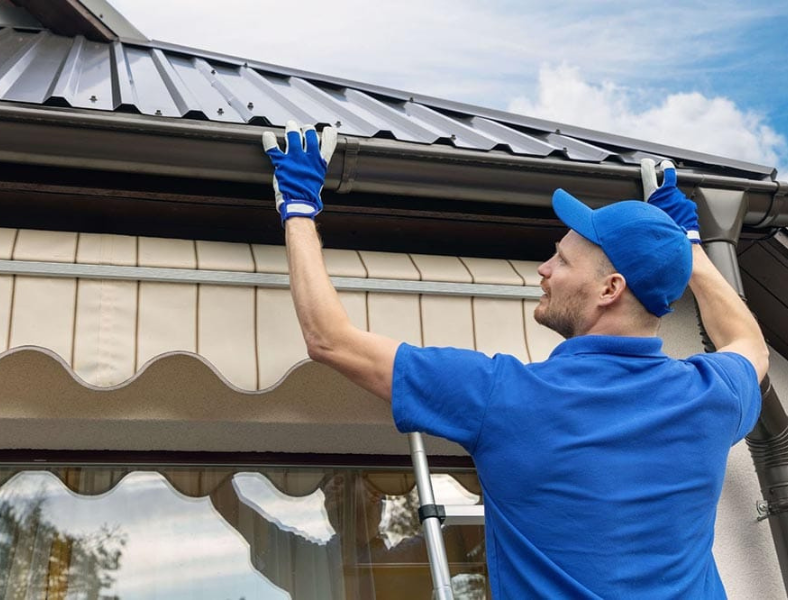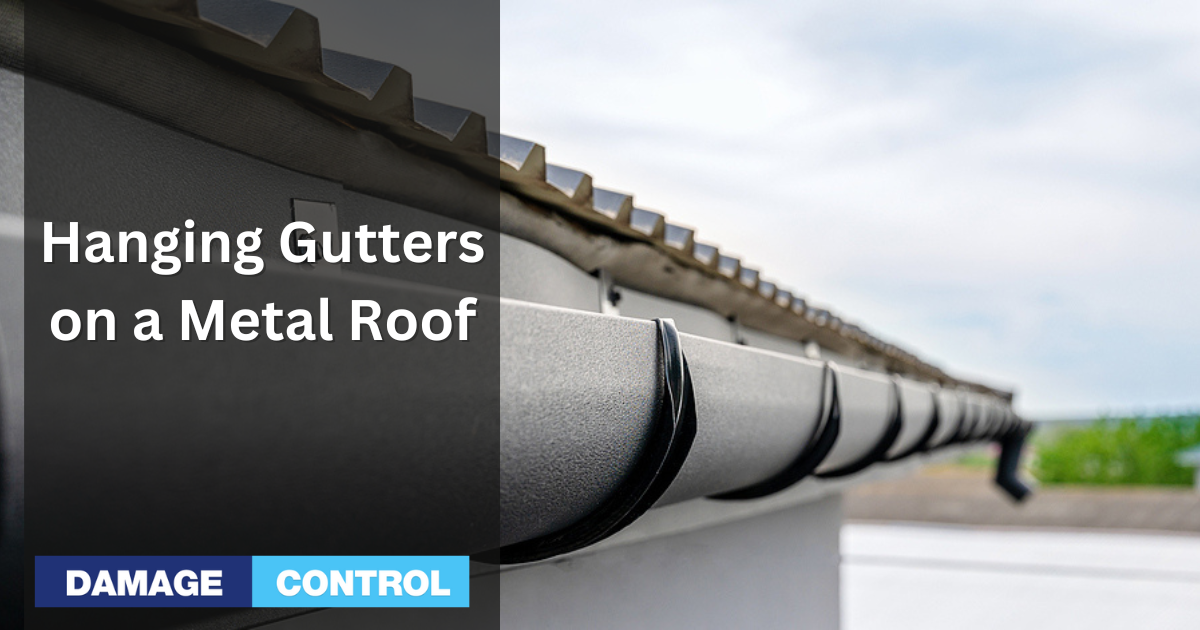Gutters play a big role in protecting our homes. They keep water away from foundations, prevent leaks, and more. But what about metal roofs? Installing gutters on them can be tricky. Don't worry, friends! We're here to help. Our mission: provide a comprehensive guide for hanging gutters on metal roofs. Let's do this!
Tools and Materials Needed
Before we start, let's gather our tools and materials. You'll need the right stuff to hang gutters on a metal roof.
Essential tools
- Ladder – To reach the roof safely.
- Tape measure – For accurate measurements.
- Level – To make sure your gutters are straight.
- Tin snips – To cut the gutters if needed.
- Drill – For attaching brackets or hangers.
Required materials
- Gutters and downspouts – Choose the right size and style for your home.
- Gutter brackets or hangers – To hold the gutters in place.
- Metal roofing screws – For secure installation.
- Sealant – To prevent leaks. Check out our handy, dandy guide about gutter sealants for more information.
- End caps and connectors – To finish your gutter system.
Gather your tools and materials, and let's get started!
Selecting the Right Gutter System
Types of gutters
K-style gutters are the most popular type, with a flat back and decorative front. They hold more water than half-round gutters and are available in many materials and colors.
Half-round gutters, as the name suggests, are shaped like a half-circle. They give a classic look to your home and work well with historical or older houses.
Factors to consider
When selecting the right gutter system for your home, keep these factors in mind:
1. Roof style and slope: Different roof designs require specific gutter systems. Steep roofs need gutters that can handle high volumes of water, while flatter roofs may require wider gutters.
2. Climate: In areas with heavy rain or snow, you'll need gutters that can handle the extra weight and volume of water. If you live in a region with strong winds, opt for a durable gutter system that can withstand the elements.
3. Material compatibility: Match your gutter material with your home's exterior. Common materials include aluminum, vinyl, copper, and steel. Aluminum is lightweight and affordable, while copper is pricier but long-lasting.
4. Aesthetics and budget: Choose gutters that complement your home's style and fit your budget. K-style gutters offer various colors and materials, while half-round gutters provide a classic look.
5. Gutter sizes: Different homes need different gutter sizes. Consider the size of your roof and the amount of rainfall in your area when selecting the right size. For more information on choosing the best gutter size for your home, check out our guide to various gutter sizes.
Preparing for Installation
Safety precautions
Before starting any installation, take these safety precautions:
- Wear protective gear like gloves, safety glasses, and non-slip shoes.
- Use a sturdy, extendable ladder with a stabilizer to prevent slipping.
- Avoid working on a wet or windy day, as it increases the risk of accidents.
Measuring and marking the roof

Proper measurement is essential for a successful gutter installation. Follow these steps:
- Measure the length of your roof's edge where the gutters will be installed.
- Note down any corners, downspouts, or other special features.
- Use chalk or a marker to indicate where brackets and downspouts will be placed.
Calculating gutter slope for proper drainage
To ensure proper drainage, gutters need a slight slope towards the downspouts. Here's how to calculate the slope:
- For every 10 feet of gutter, plan a slope of 1/4 inch.
- Measure the distance from the highest point of the gutter to the downspout.
- Multiply the distance by 1/4 inch to find the total slope needed.
- Adjust the gutter brackets' height accordingly, with the highest point farthest from the downspout and the lowest point near it.
Following these steps will prepare you for a successful gutter installation. Remember, safety is key, and taking the time to measure and calculate the gutter slope will ensure proper drainage for your new system.
Installing Gutter Brackets or Hangers
Choosing the right type of brackets or hangers for metal roofs
To install gutters on a metal roof, you'll need brackets or hangers specifically designed for metal roofs. Common types include:
- Strap hangers: These are attached to the roof using metal straps, providing strong support for gutters.
- Hidden hangers: These are installed inside the gutter and not visible from the ground, offering a clean look.
- Roof hangers: These attach directly to the metal roof, holding the gutter in place.
Spacing and positioning guidelines
Proper spacing and positioning of gutter brackets or hangers ensure a stable gutter system. Keep these tips in mind:
- Space brackets or hangers 24 to 36 inches apart, depending on the gutter material and weight.
- Position hangers closer together in areas with heavy snow or ice, as it provides extra support.
- Place hangers on the high side of the gutter, ensuring a secure fit against the metal roof.
Attaching brackets or hangers securely to the metal roof
To attach gutter brackets or hangers to your metal roof, follow these steps:
- Mark the positions where the brackets or hangers will be installed, using the spacing guidelines above.
- Pre-drill holes in the metal roof at each marked location, using a drill bit suitable for metal.
- Attach the brackets or hangers using appropriate screws or fasteners, ensuring a tight and secure fit.
By choosing the right type of brackets or hangers, spacing them properly, and attaching them securely to your metal roof, you'll create a stable and durable gutter system that can handle the elements.
Assembling and Attaching the Gutters
Cutting gutters to the correct length
Before installing gutters, you'll need to cut them to the right length. Here's how:
- Measure the length of the roof edge where the gutter will be installed.
- Mark the gutter at the measured length.
- Use a hacksaw or tin snips to cut the gutter, ensuring a clean and straight cut.
Sealing joints and connecting gutter sections
To prevent leaks, you'll need to seal joints and connect gutter sections properly. Follow these steps:
- Apply gutter sealant to the inside of the gutter joint.
- Slide the gutter sections together, overlapping the sealed joint.
- Secure the joint with screws or pop rivets for added stability.
Installing end caps and downspouts
End caps and downspouts are essential components of your gutter system. To install them:
- Attach end caps to the ends of the gutters using sealant and screws or rivets.
- Measure and cut the downspout to the desired length.
- Attach the downspout to the gutter outlet using screws or rivets, ensuring a secure connection.
Fastening gutters to the brackets or hangers
Once the gutters are assembled, you must fasten them to the brackets or hangers. Here's how:
- Lift the gutter and align it with the installed brackets or hangers.
- Secure the gutter to the brackets or hangers using screws, clips, or fasteners, depending on the hanger type.
- Double-check the gutter slope and adjust if necessary.
By following these steps, you'll successfully assemble and attach your gutters, creating a well-functioning gutter system that will protect your home from water damage.
Testing and Maintaining Your Gutter System
Checking for leaks and proper drainage
After installation, it's crucial to test your gutter system for leaks and proper drainage. Here's how:
- Use a garden hose to run water through the gutters and downspouts.
- Observe the flow of water, ensuring it drains correctly and doesn't pool in the gutters.
- Check for any leaks at the joints, end caps, or downspouts, and repair if necessary.
Seasonal maintenance tips
Regular maintenance is key to keeping your gutters functioning well. Follow these seasonal tips:
- Spring: Inspect your gutters for damage from winter weather, and clear out any debris, like leaves and twigs.
- Summer: Check for sagging or loose gutters and tighten any loose brackets or hangers.
- Fall: Clean your gutters frequently to prevent clogs from falling leaves and debris.
- Winter: Keep an eye on snow and ice buildup, and remove it carefully to prevent damage.
Troubleshooting common issues
If you encounter issues with your gutter system, try these troubleshooting tips:
- Leaking gutters: Apply gutter sealant to the leaking area, or replace damaged sections if needed.
- Clogged downspouts: Use a plumber's snake or a hose to remove the blockage.
- Sagging gutters: Tighten or replace loose brackets or hangers to provide proper support.
By testing and maintaining your gutter system, you'll ensure its longevity and protect your home from potential water damage. Stay proactive with seasonal maintenance and address any issues promptly to keep your gutters in top shape.
Conclusion
In conclusion, installing gutters on a metal roof is a multi-step process that requires careful planning, preparation, and execution. From selecting the right gutter system and taking safety precautions to assembling and attaching the gutters, every step is crucial for a successful installation. Proper maintenance and regular inspections will help your gutters last longer and protect your home from water damage. Don't hesitate to seek professional help if you're unsure about any aspect of the installation or maintenance process.
Now that you've learned how to install gutters on a metal roof, why not explore some related articles? Read about the benefits of seamless gutter systems, learn about how much gutter guard costs, or find out how to use a gutter machine for a seamless installation. Dive deeper into the world of gutters and find the perfect solution for your home.

